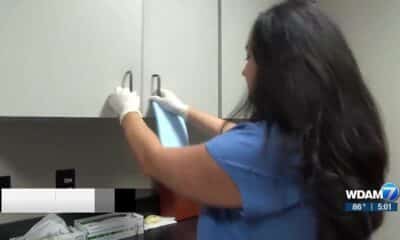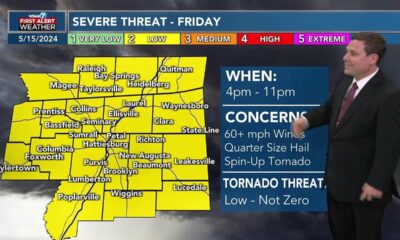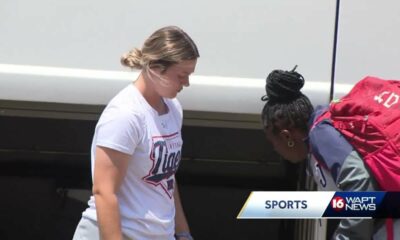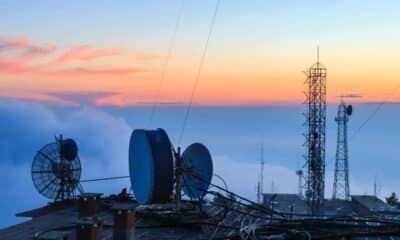Kaiser Health News
Congressman Seeks to Plug ‘Shocking Loophole’ Exposed by KHN Investigation
by Sarah Jane Tribble, Kaiser Health News
Tue, 28 Mar 2023 09:00:00 +0000
A U.S. lawmaker is taking action after a KHN investigation exposed weaknesses in the federal system meant to stop repeat Medicare and Medicaid fraud and abuse.
Rep. Lloyd Doggett (D-Texas) said he decided to introduce a bill in the House late last week after KHN's reporting revealed what he called a “shocking loophole.”
“The ability of fraudsters to continue billing Medicare for services is outrageous,” Doggett said. “This is an obvious correction that is needed to safeguard our system. Wherever there are large amounts of government money available, someone tries to steal it.”
KHN found a laundry list of weaknesses that allows people accused or convicted of fraud to easily sidestep bans imposed by federal officials. Among those gaps is the Centers for Medicare & Medicaid Services' lack of authority to deny or revoke National Provider Identifier, or NPI, numbers after federal regulators have prohibited a person or business from receiving payments from government programs.
Doctors, nurses, other practitioners, and health businesses use the unique, 10-digit NPI numbers to bill and file claims with insurers and others, including Medicare and Medicaid.
Taking away the NPI would “be equivalent of prohibiting a practitioner from practicing in total,” Dara Corrigan, director of CMS' Center for Program Integrity, wrote in an email response to questions about KHN's investigation. CMS declined to comment on Doggett's proposed legislation.
The bill, HR 1745, would give CMS the authority to deactivate NPIs tied to anyone convicted of waste, fraud, or abuse and whose name appears on the exclusions list kept by the Office of Inspector General for the U.S. Department of Health and Human Services. The proposed law would also require CMS to implement recommendations that the inspector general has made to improve NPI reporting and provider transparency.
“This strikes me as what should be an easy bipartisan measure,” Doggett said, adding that he had presented the bill in a face-to-face meeting with Rep. Jason Smith (R-Mo.), who chairs the House Ways and Means Committee. Doggett also alerted that panel's health subcommittee chair, Rep. Vern Buchanan (R-Fla.).
“They both talk about the need to eliminate fraud, and this is one modest but important way to do it,” Doggett said. Neither Smith's nor Buchanan's offices responded to requests for comment.
The OIG declined to comment.
Former Justice Department officials told KHN that repeat violators are savvy and find ways to circumvent the system. KHN examined a sample of 300 health care business owners and executives who are among more than 1,600 on the OIG's exclusion list since January 2017. Journalists reviewed court and property records, social media, and other publicly available documents.
KHN found:
- Eight people appeared to be serving or served in roles that could violate their bans;
- Six transferred control of a business to family or household members;
- Nine had previous, unrelated felony or fraud convictions, and went on to defraud the health care system;
- And seven were repeat violators, some of whom raked in tens of millions of federal health care dollars before getting caught by officials after a prior exclusion.
Doggett's bill is “a pretty smart step in the right direction in fixing this issue,” said John Kelly, a former assistant chief of health care fraud at the Department of Justice who is now a partner for the law firm Barnes & Thornburg. Kelly had previously recommended that NPIs should be “essentially wiped clean” when a person is on the exclusions list.
Kelly, who confirmed that Doggett's office reached out to him after KHN's investigation was published in December, said taking the NPI number away “certainly doesn't eliminate all risk” but it's a move “in the right direction.”
“If you want to bill Medicare, you have to have a valid NPI,” Kelly said.
KHN (Kaiser Health News) is a national newsroom that produces in-depth journalism about health issues. Together with Policy Analysis and Polling, KHN is one of the three major operating programs at KFF (Kaiser Family Foundation). KFF is an endowed nonprofit organization providing information on health issues to the nation.
USE OUR CONTENT
This story can be republished for free (details).
By: Sarah Jane Tribble, Kaiser Health News
Title: Congressman Seeks to Plug ‘Shocking Loophole' Exposed by KHN Investigation
Sourced From: khn.org/news/article/cms-exclusions-loopholes-congress-legislation/
Published Date: Tue, 28 Mar 2023 09:00:00 +0000
Kaiser Health News
Medics at UCLA Protest Say Police Weapons Drew Blood and Cracked Bones
Molly Castle Work and Brett Kelman
Thu, 16 May 2024 09:00:00 +0000
Inside the protesters' encampment at UCLA, beneath the glow of hanging flashlights and a deafening backdrop of exploding flash-bangs, OB-GYN resident Elaine Chan suddenly felt like a battlefield medic.
related coverage from 2020
Less-Lethal Weapons Blind, Maim and Kill. Victims Say Enough Is Enough.
Police were pushing into the camp after an hours-long standoff. Chan, 31, a medical tent volunteer, said protesters limped in with severe puncture wounds, but there was little hope of getting them to a hospital through the chaos outside. Chan suspects the injuries were caused by rubber bullets or other “less lethal” projectiles, which police have confirmed were fired at protesters.
“It would pierce through skin and gouge deep into people's bodies,” she said. “All of them were profusely bleeding. In OB-GYN we don't treat rubber bullets. … I couldn't believe that this was allowed to be [done to] civilians — students — without protective gear.”
The UCLA protest, which gathered thousands in opposition to Israel's ongoing bombing of Gaza, began in April and grew to a dangerous crescendo this month when counterprotesters and police clashed with the activists and their supporters.
In interviews with KFF Health News, Chan and three other volunteer medics described treating protesters with bleeding wounds, head injuries, and suspected broken bones in a makeshift clinic cobbled together in tents with no electricity or running water. The medical tents were staffed day and night by a rotating team of doctors, nurses, medical students, EMTs, and volunteers with no formal medical training.
At times, the escalating violence outside the tent isolated injured protesters from access to ambulances, the medics said, so the wounded walked to a nearby hospital or were carried beyond the borders of the protest so they could be driven to the emergency room.
“I've never been in a setting where we're blocked from getting higher level of care,” Chan said. “That was terrifying to me.”
Three of the medics interviewed by KFF Health News said they were present when police swept the encampment May 2 and described multiple injuries that appeared to have been caused by “less lethal” projectiles.
Less lethal projectiles — including beanbags filled with metal pellets, sponge-tipped rounds, and projectiles commonly known as rubber bullets — are used by police to subdue suspects or disperse crowds or protests. Police drew widespread condemnation for using the weapons against Black Lives Matter demonstrations that swept the country after the killing of George Floyd in 2020. Although the name of these weapons downplays their danger, less lethal projectiles can travel upward of 200 mph and have a documented potential to injure, maim, or kill.
The medics' interviews directly contradict an account from the Los Angeles Police Department. After police cleared the encampment, LAPD Chief Dominic Choi said in a post on the social platform X that there were “no serious injuries to officers or protestors” as police moved in and made more than 200 arrests.
In response to questions from KFF Health News, both the LAPD and California Highway Patrol said in emailed statements that they would investigate how their officers responded to the protest. The LAPD statement said the agency was conducting a review of how it and other law enforcement agencies responded, which would lead to a “detailed report.”
The Highway Patrol statement said officers warned the encampment that “non-lethal rounds” may be used if protesters did not disperse, and after some became an “immediate threat” by “launching objects and weapons,” some officers used “kinetic specialty rounds to protect themselves, other officers, and members of the public.” One officer received minor injuries, according to the statement.
Video footage that circulated online after the protest appeared to show a Highway Patrol officer firing less lethal projectiles at protesters with a shotgun.
“The use of force and any incident involving the use of a weapon by CHP personnel is a serious matter, and the CHP will conduct a fair and impartial investigation to ensure that actions were consistent with policy and the law,” the Highway Patrol said in its statement.
The UCLA Police Department, which was also involved with the protest response, did not respond to requests for comment.
Jack Fukushima, 28, a UCLA medical student and volunteer medic, said he witnessed a police officer shoot at least two protesters with less lethal projectiles, including a man who collapsed after being hit “square in the chest.” Fukushima said he and other medics escorted the stunned man to the medical tent then returned to the front lines to look for more injured.
“It did really feel like a war,” Fukushima said. “To be met with such police brutality was so disheartening.”
Back on the front line, police had breached the borders of the encampment and begun to scrum with protesters, Fukushima said. He said he saw the same officer who had fired earlier shoot another protester in the neck.
The protester dropped to the ground. Fukushima assumed the worst and rushed to his side.
“I find him, and I'm like, ‘Hey, are you OK?'” Fukushima said. “To the point of courage of these undergrads, he's like, ‘Yeah, it's not my first time.' And then just jumps right back in.”
Sonia Raghuram, 27, another medical student stationed in the tent, said that during the police sweep she tended to a protester with an open puncture wound on their back, another with a quarter-sized contusion in the center of their chest, and a third with a “gushing” cut over their right eye and possible broken rib. Raghuram said patients told her the wounds were caused by police projectiles, which she said matched the severity of their injuries.
The patients made it clear the police officers were closing in on the medical tent, Raghuram said, but she stayed put.
“We will never leave a patient,” she said, describing the mantra in the medical tent. “I don't care if we get arrested. If I'm taking care of a patient, that's the thing that comes first.”
The UCLA protest is one of many that have been held on college campuses across the country as students opposed to Israel's ongoing war in Gaza demand universities support a ceasefire or divest from companies tied to Israel. Police have used force to remove protesters at Columbia University, Emory University, and the universities of Arizona, Utah, and South Florida, among others.
At UCLA, student protesters set up a tent encampment on April 25 in a grassy plaza outside the campus's Royce Hall theater, eventually drawing thousands of supporters, according to the Los Angeles Times. Days later, a “violent mob” of counterprotesters “attacked the camp,” the Times reported, attempting to tear down barricades along its borders and throwing fireworks at the tents inside.
The following night, police issued an unlawful assembly order, then swept the encampment in the early hours of May 2, clearing tents and arresting hundreds by dawn.
Police have been widely criticized for not intervening as the clash between protesters and counterprotesters dragged on for hours. The University of California system announced it has hired an independent policing consultant to investigate the violence and “resolve unanswered questions about UCLA's planning and protocols, as well as the mutual aid response.”
Charlotte Austin, 34, a surgery resident, said that as counterprotesters were attacking she also saw about 10 private campus security officers stand by, “hands in their pockets,” as students were bashed and bloodied.
Austin said she treated patients with cuts to the face and possible skull fractures. The medical tent sent at least 20 people to the hospital that evening, she said.
“Any medical professional would describe these as serious injuries,” Austin said. “There were people who required hospitalization — not just a visit to the emergency room — but actual hospitalization.”
Police Tactics ‘Lawful but Awful'
UCLA protesters are far from the first to be injured by less lethal projectiles.
In recent years, police across the U.S. have repeatedly fired these weapons at protesters, with virtually no overarching standards governing their use or safety. Cities have spent millions to settle lawsuits from the injured. Some of the wounded have never been the same.
During the nationwide protests following the police killing of George Floyd in 2020, at least 60 protesters sustained serious injuries — including blinding and a broken jaw — from being shot with these projectiles, sometimes in apparent violations of police department policies, according to a joint investigation by KFF Health News and USA Today.
In 2004, in Boston, a college student celebrating a Red Sox victory was killed by a projectile filled with pepper-based irritant when it tore through her eye and into her brain.
“They're called less lethal for a reason,” said Jim Bueermann, a former police chief of Redlands, California, who now leads the Future Policing Institute. “They can kill you.”
Bueermann, who reviewed video footage of the police response at UCLA at the request of KFF Health News, said the footage shows California Highway Patrol officers firing beanbag rounds from a shotgun. Bueermann said the footage did not provide enough context to determine if the projectiles were being used “reasonably,” which is a standard established by federal courts, or being fired “indiscriminately,” which was outlawed by a California law in 2021.
“There is a saying in policing — ‘lawful but awful' — meaning that it was reasonable under the legal standards but it looks terrible,” Bueermann said. “And I think a cop racking multiple rounds into a shotgun, firing into protesters, doesn't look very good.”
This article was produced by KFF Health News, which publishes California Healthline, an editorially independent service of the California Health Care Foundation.
——————————
By: Molly Castle Work and Brett Kelman
Title: Medics at UCLA Protest Say Police Weapons Drew Blood and Cracked Bones
Sourced From: kffhealthnews.org/news/article/ucla-protest-gaza-israel-rubber-bullets-injuries-volunteer-medics/
Published Date: Thu, 16 May 2024 09:00:00 +0000
Kaiser Health News
Why One New York Health System Stopped Suing Its Patients
Noam N. Levey
Wed, 15 May 2024 09:00:00 +0000
ROCHESTER, N.Y. — Jolynn Mungenast spends her days looking for ways to help people pay their hospital bills.
Working out of a warehouse-like building in a scruffy corner of this former industrial town, Mungenast gently walks patients through health insurance options, financial aid, and payment plans. Most want to pay, said Mungenast, a financial counselor at Rochester Regional Health. Very often, they simply can't.
“They're scared. They're nervous. They're upset,” said Mungenast, who on one recent call worked with an older patient to settle a $143 bill. “They do think ‘I don't want this to affect my credit rating. I don't want you to come take my house.'”
At Rochester Regional Health, that won't happen. The nonprofit system in upstate New York is one of only a few nationally that bar all aggressive collection activities. Patients who don't pay won't be taken to court. Their wages won't be garnished. They won't end up with liens on their homes or be denied care. And unpaid bills won't sink their credit scores.
American hospital officials often insist that lawsuits and other aggressive collections, though unsavory, are necessary to protect health systems' finances and deter freeloading.
But at Rochester Regional, ditching these collection tactics hasn't hurt the bottom line, said Jennifer Eslinger, chief operating officer. The system has even been able to move staff out of its collections department as it spends less to go after patients who haven't paid.
Eslinger said there's been another benefit to the change: rebuilding trust with patients.
“We think and talk a lot and strategize a lot about where is the distrust in health care,” she said. “We have to remove that as a barrier to meaningful health care. We have to get the trust with the populations that we serve so that they can get the care that they need.”
‘Folks Cannot Afford This'
Rochester Regional, a large health system serving a wide swath of communities along the south shore of Lake Ontario, is big, with more than $3 billion in annual revenue.
But in a place where once-mighty employers like Kodak and Xerox have withered, finances can be challenging. In 2022, Rochester Regional finished nearly $200 million in the red.
Patients have their own challenges. Unable to afford their bills, many ended up in collections, or even on the receiving end of lawsuits. “We would go to court,” acknowledged Lisa Poworoznek, head of financial counseling at Rochester Regional.
Then, before the pandemic, hospital leaders looked more closely at why patients weren't paying.
The barriers became clear, Poworoznek said: confusing insurance plans, high deductibles, and inadequate savings. “There are so many different situations that patients have,” she said. “It's really just not as simple as demanding payment and then filing legal action.”
Nationally, nearly half of adults are unable to cover a $500 medical bill without going into debt, a 2022 KFF poll found. At the same time, the average annual deductible for a single worker with job-based coverage now tops $1,500.
Instead of chasing people who didn't pay — a costly process that often yields meager returns — Rochester Regional resolved to find ways to get patients to settle bills before collections started.
The health system undertook new efforts to enroll people in health insurance. New York has among the most robust safety-net systems in the country.
Rochester Regional also bolstered its financial assistance program, making it easier for low-income patients to access free or discounted care.
At many hospitals, applying for aid is complicated — long applications that demand extensive information about patients' income and assets, including cars, retirement accounts, and property, KFF Health News has found. Patients applying for aid at Rochester Regional are asked to disclose only their income.
Finally, the health system looked for ways to get more people on payment plans so they could pay off big bills over a year or two. Importantly, the payment plans are interest-free.
That was a change. Rochester Regional, like some other major health systems across the country such as Atrium Health, used to rely on financing companies that charged interest, which could add thousands of dollars to patients' debts.
“Folks cannot afford this,” Poworoznek said.
Ending ‘Extraordinary Collection Actions'
Working more closely with patients on their bills allowed Rochester Regional to stop taking them to court.
The health system also stopped reporting people to credit bureaus, a practice many medical providers use that can depress consumers' credit scores, making it harder to rent an apartment, get a car loan, or even get a job.
In 2020, Rochester Regional adopted a written policy barring all aggressive collections by the system or its contracted collection agencies.
That put Rochester Regional in select company. A 2022 KFF Health News investigation of billing practices at 528 hospitals around the country found just 19 that explicitly prohibit what are called extraordinary collection actions.
Among them are leading academic medical centers, including UCLA and Stanford University, but also community hospitals such as El Camino Hospital in California's Bay Area and St. Anthony Community Hospital outside New York City.
Also barring extraordinary collection actions: the University of Vermont Medical Center; Ochsner Health, a large New Orleans-based nonprofit; and UPMC, a mammoth system based in Pittsburgh. Like Rochester Regional, UPMC officials said they were able to scrap aggressive collections by developing better systems that allow patients to pay off their bills.
Elisabeth Benjamin, a vice president at the Community Service Society of New York, a nonprofit that has led efforts to restrict aggressive hospital collections, said there's no reason more hospitals shouldn't follow suit, particularly nonprofits that are expected to serve their communities in exchange for their tax-exempt status.
“The value is to promote health, to care about a population, to promote health equity,” Benjamin said. “Suing people for medical debt or engaging in extraordinary collection actions is really anathema to all those values,” she said. “Forget about your ‘cancer-mobile' or your child vaccination clinic.”
Rochester Regional's approach doesn't eliminate medical debt, which burdens an estimated 100 million people in the U.S. And payment plans like those the system encourages can still mean big sacrifices for some families.
But Benjamin applauded Rochester Regional's ban on aggressive collections. “I give them big props,” she said. “It never should have been allowed.”
New laws in New York now prohibit all medical bills from being reported to credit bureaus and restrict other collection tactics, such as wage garnishments.
Many hospital finance officials nevertheless say they need the option to pursue patients who have the means to pay.
“Maybe it's on a very specific case where there is an issue with someone just not paying their bill,” said Richard Gundling, a senior vice president at the Healthcare Financial Management Association, a trade group.
But at Rochester Regional's finance offices, officials say they almost never find patients who just refuse to pay. More often, the problem is the bills are simply too big.
“People just don't have $5,000 to pay off that bill,” Poworoznek said.
On her calls with patients, Mungenast tries to reassure the patients on the other end of the line. “Put yourself in their shoes,” she said. “How would it be if that was you receiving that?”
About This Project
“Diagnosis: Debt” is a reporting partnership between KFF Health News and NPR exploring the scale, impact, and causes of medical debt in America.
The series draws on original polling by KFF, court records, federal data on hospital finances, contracts obtained through public records requests, data on international health systems, and a yearlong investigation into the financial assistance and collection policies of more than 500 hospitals across the country.
Additional research was conducted by the Urban Institute, which analyzed credit bureau and other demographic data on poverty, race, and health status for KFF Health News to explore where medical debt is concentrated in the U.S. and what factors are associated with high debt levels.
The JPMorgan Chase Institute analyzed records from a sampling of Chase credit card holders to look at how customers' balances may be affected by major medical expenses. And the CED Project, a Denver nonprofit, worked with KFF Health News on a survey of its clients to explore links between medical debt and housing instability.
KFF Health News journalists worked with KFF public opinion researchers to design and analyze the “KFF Health Care Debt Survey.” The survey was conducted Feb. 25 through March 20, 2022, online and via telephone, in English and Spanish, among a nationally representative sample of 2,375 U.S. adults, including 1,292 adults with current health care debt and 382 adults who had health care debt in the past five years. The margin of sampling error is plus or minus 3 percentage points for the full sample and 3 percentage points for those with current debt. For results based on subgroups, the margin of sampling error may be higher.
Reporters from KFF Health News and NPR also conducted hundreds of interviews with patients across the country; spoke with physicians, health industry leaders, consumer advocates, debt lawyers, and researchers; and reviewed scores of studies and surveys about medical debt.
——————————
By: Noam N. Levey
Title: Why One New York Health System Stopped Suing Its Patients
Sourced From: kffhealthnews.org/news/article/diagnosis-debt-rochester-new-york-health-system-stopped-suing-patients-over-medical-bills/
Published Date: Wed, 15 May 2024 09:00:00 +0000
Did you miss our previous article…
https://www.biloxinewsevents.com/tribal-nations-invest-opioid-settlement-funds-in-traditional-healing-to-treat-addiction/
Kaiser Health News
Tribal Nations Invest Opioid Settlement Funds in Traditional Healing to Treat Addiction
Aneri Pattani and Jazmin Orozco Rodriguez
Wed, 15 May 2024 09:00:00 +0000
PRESQUE ISLE, Maine — Outside the Mi'kmaq Nation's health department sits a dome-shaped tent, built by hand from saplings and covered in black canvas. It's one of several sweat lodges on the tribe's land, but this one is dedicated to helping people recover from addiction.
Up to 10 people enter the lodge at once. Fire-heated stones — called grandmothers and grandfathers, for the spirits they represent — are brought inside. Water is splashed on the stones, and the lodge fills with steam. It feels like a sauna, but hotter. The air is thicker, and it's dark. People pray and sing songs. When they leave the lodge, it is said, they reemerge from the mother's womb. Cleansed. Reborn.
The experience can be “a vital tool” in healing, said Katie Espling, health director for the roughly 2,000-member tribe.
She said patients in recovery have requested sweat lodges for years as a cultural element to complement the counseling and medications the tribe's health department already provides. But insurance doesn't cover sweat ceremonies, so, until now, the department couldn't afford to provide them.
In the past year, the Mi'kmaq Nation received more than $150,000 from settlements with companies that made or sold prescription painkillers and were accused of exacerbating the overdose crisis. A third of that money was spent on the sweat lodge.
Health care companies are paying out more than $1.5 billion to hundreds of tribes over 15 years. This windfall is similar to settlements that many of the same companies are paying to state governments, which total about $50 billion.
To some people, the lower payout for tribes corresponds to their smaller population. But some tribal citizens point out that the overdose crisis has had a disproportionate effect on their communities. Native Americans had the highest overdose death rates of any racial group each year from 2020 to 2022. And federal officials say those statistics were likely undercounted by about 34% because Native Americans' race is often misclassified on death certificates.
Still, many tribal leaders are grateful for the settlements and the unique way the money can be spent: Unlike the state payments, money sent to tribes can be used for traditional and cultural healing practices — anything from sweat lodges and smudging ceremonies to basketmaking and programs that teach tribal languages.
“To have these dollars to do that, it's really been a gift,” said Espling of the Mi'kmaq tribe. “This is going to absolutely be fundamental to our patients' well-being” because connecting with their culture is “where they'll really find the deepest healing.”
Public health experts say the underlying cause of addiction in many tribal communities is intergenerational trauma, resulting from centuries of brutal treatment, including broken treaties, land theft, and a government-funded boarding school system that sought to erase the tribes' languages and cultures. Along with a long-running lack of investment in the Indian Health Service, these factors have led to lower life expectancy and higher rates of addiction, suicide, and chronic diseases.
Using settlement money to connect tribal citizens with their traditions and reinvigorate pride in their culture can be a powerful healing tool, said Andrea Medley, a researcher with the Johns Hopkins Center for Indigenous Health and a member of the Haida Nation. She helped create principles for how tribes can consider spending settlement money.
Medley said that having respect for those traditional elements outlined explicitly in the settlements is “really groundbreaking.”
‘A Drop in the Bucket'
Of the 574 federally recognized tribes, more than 300 have received payments so far, totaling more than $371 million, according to Kevin Washburn, one of three court-appointed directors overseeing the tribal settlements.
Although that sounds like a large sum, it pales in comparison with what the addiction crisis has cost tribes. There are also hundreds of tribes that are excluded from the payments because they aren't federally recognized.
“These abatement funds are like a drop in the bucket compared to what they've spent, compared to what they anticipate spending,” said Corey Hinton, a lawyer who represented several tribes in the opioid litigation and a citizen of the Passamaquoddy Tribe. “Abatement is a cheap term when we're talking about a crisis that is still engulfing and devastating communities.”
Even leaders of the Navajo Nation — the largest federally recognized tribe in the United States, which has received $63 million so far — said the settlements can't match the magnitude of the crisis.
“It'll do a little dent, but it will only go so far,” said Kim Russell, executive director of the Navajo Department of Health.
The Navajo Nation is trying to stretch the money by using it to improve its overall health system. Officials plan to use the payouts to hire more coding and billing employees for tribe-operated hospitals and clinics. Those workers would help ensure reimbursements keep flowing to the health systems and would help sustain and expand services, including addiction treatment and prevention, Russell said.
Navajo leaders also want to hire more clinicians specializing in substance use treatment, as well as primary care doctors, nurses, and epidemiologists.
“Building buildings is not what we want” from the opioid settlement funds, Russell said. “We're nation-building.”
High Stakes for Small Tribes
Smaller nations like the Poarch Band of Creek Indians in southern Alabama are also strategizing to make settlement money go further.
For the tribe of roughly 2,900 members, that has meant investing $500,000 — most of what it has received so far — into a statistical modeling platform that its creators say will simulate the opioid crisis, predict which programs will save the most lives, and help local officials decide the most effective use of future settlement cash.
Some recovery advocates have questioned the model's value, but the tribe's vice chairman, Robert McGhee, said it would provide the data and evidence needed to choose among efforts competing for resources, such as recovery housing or peer support specialists. The tribe wants to do both, but realistically, it will have to prioritize.
“If we can have this model and we put the necessary funds to it and have the support, it'll work for us,” McGhee said. “I just feel it in my gut.”
The stakes are high. In smaller communities, each death affects the whole tribe, McGhee said. The loss of one leader marks decades of lost knowledge. The passing of a speaker means further erosion of the Native language.
For Keesha Frye, who oversees the Poarch Band of Creek Indians' tribal court and the sober living facility, using settlement money effectively is personal. “It means a lot to me to get this community well because this is where I live and this is where my family lives,” she said.
Erik Lamoreau in Maine also brings personal ties to this work. More than a decade ago, he sold drugs on Mi'kmaq lands to support his own addiction.
“I did harm in this community and it was really important for me to come back and try to right some of those wrongs,” Lamoreau said.
Today, he works for the tribe as a peer recovery coordinator, a new role created with the opioid settlement funds. He uses his experience to connect with others and help them with recovery — whether that means giving someone a ride to court, working on their résumé, exercising together at the gym, or hosting a cribbage club, where people play the card game and socialize without alcohol or drugs.
Beginning this month, Lamoreau's work will also involve connecting clients who seek cultural elements of recovery to the new sweat lodge service — an effort he finds promising.
“The more in tune you are with your culture — no matter what culture that is — it connects you to something bigger,” Lamoreau said. “And that's really what we look at when we're in recovery, when we talk about spiritual connection. It's something bigger than you.”
——————————
By: Aneri Pattani and Jazmin Orozco Rodriguez
Title: Tribal Nations Invest Opioid Settlement Funds in Traditional Healing to Treat Addiction
Sourced From: kffhealthnews.org/news/article/tribal-nations-opioid-settlement-funds-cultural-traditional-healing/
Published Date: Wed, 15 May 2024 09:00:00 +0000
Did you miss our previous article…
https://www.biloxinewsevents.com/after-a-childs-death-california-weighs-rules-for-phys-ed-during-extreme-weather/
-
SuperTalk FM3 days ago
Martin Lawrence making 3 stops in Mississippi on comedy tour
-
Our Mississippi Home2 days ago
Beat the Heat with Mississippi’s Best Waterparks
-
Mississippi Today6 days ago
Lawmakers may have to return to Capitol May 14 to override Gov. Tate Reeves’ potential vetoes
-
Mississippi News6 days ago
Man arrested for allegedly breaking into home, robbing owner
-
SuperTalk FM7 days ago
Couple arrested after husband received unemployment benefits while in prison
-
Our Mississippi Home3 days ago
Charlie’s U-Pik: Opening Soon for the Summer Season
-
Mississippi News Video5 days ago
Local dentists offer free dental care in Amory
-
Kaiser Health News2 days ago
Medicaid ‘Unwinding’ Decried as Biased Against Disabled People




































